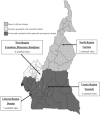Viral etiology of influenza-like illnesses in Cameroon, January-December 2009
- PMID: 23169968
- PMCID: PMC7107314
- DOI: 10.1093/infdis/jis573
Viral etiology of influenza-like illnesses in Cameroon, January-December 2009
Abstract
Background: No information is available on the viral etiology of upper respiratory tract infections in Cameroon.
Methods: We prospectively enrolled outpatients with influenza-like illness (ILI) presenting at 14 sentinel clinics located across the country from January through December 2009. The specimens were tested using real-time and multiplex reverse-transcription polymerase chain reaction methods for the detection of 15 RNA respiratory viruses.
Results: We detected at least 1 respiratory virus in 365 of 561 specimens (65.1%). Overall, influenza virus was the most commonly detected virus (28.2% of specimens), followed by human rhinovirus (17.8%); parainfluenza virus (PIV) types 1-4 (7.5%); enterovirus (5.9%); respiratory syncytial virus (RSV; 5.7%); human coronavirus (HCoV) OC43, 229E, NL63, and HKU1 (5.3%); and human metapneumovirus (HMPV; 5.0%). RSV (26 of 31 specimens [83.9%]), PIV (30 of 39 [76.9%]), and HRV (64 of 99 [64.6%]) were most common among children <5 years of age. Coinfections were found in 53 of 365 positive specimens (14.5%), and most (71.7%) were in children <5 years of age. While influenza virus, enterovirus, RSV, and HMPV had a defined period of circulation, the other viruses were detected throughout the year.
Conclusions: We found that respiratory viruses play an important role in the etiology of ILI in Cameroon, particularly in children <5 years of age.
Figures



Similar articles
-
[Detection of respiratory viruses in influenza-like illness in Shijiazhuang, China in 2011].Bing Du Xue Bao. 2014 Jul;30(4):391-5. Bing Du Xue Bao. 2014. PMID: 25272592 Chinese.
-
[Prevalence and seasonal distribution of respiratory viruses in patients with acute respiratory tract infections, 2002-2014].Mikrobiyol Bul. 2015 Apr;49(2):188-200. doi: 10.5578/mb.9024. Mikrobiyol Bul. 2015. PMID: 26167819 Turkish.
-
[Simultaneous detection of respiratory viruses and influenza A virus subtypes using multiplex PCR].Mikrobiyol Bul. 2014 Oct;48(4):652-60. doi: 10.5578/mb.8221. Mikrobiyol Bul. 2014. PMID: 25492660 Turkish.
-
Etiology of acute viral respiratory infections common in Pakistan: A review.Rev Med Virol. 2019 Mar;29(2):e2024. doi: 10.1002/rmv.2024. Epub 2018 Dec 12. Rev Med Virol. 2019. PMID: 30548740 Free PMC article.
-
Effects of Non-Pharmacological Interventions on Respiratory Viruses Other Than SARS-CoV-2: Analysis of Laboratory Surveillance and Literature Review From 2018 to 2021.J Korean Med Sci. 2022 May 30;37(21):e172. doi: 10.3346/jkms.2022.37.e172. J Korean Med Sci. 2022. PMID: 35638198 Free PMC article. Review.
Cited by
-
Genetic Diversity of Human Respiratory Syncytial Virus during COVID-19 Pandemic in Yaoundé, Cameroon, 2020-2021.Microorganisms. 2024 May 8;12(5):952. doi: 10.3390/microorganisms12050952. Microorganisms. 2024. PMID: 38792782 Free PMC article.
-
The clinical and etiological characteristics of influenza-like illness (ILI) in outpatients in Shanghai, China, 2011 to 2013.PLoS One. 2015 Mar 30;10(3):e0119513. doi: 10.1371/journal.pone.0119513. eCollection 2015. PLoS One. 2015. PMID: 25822885 Free PMC article.
-
Influence of meteorological parameters in the seasonality of influenza viruses circulating in Northern Cameroon.Influenza Other Respir Viruses. 2019 Mar;13(2):158-165. doi: 10.1111/irv.12612. Epub 2018 Dec 17. Influenza Other Respir Viruses. 2019. PMID: 30220100 Free PMC article.
-
Clinico-epidemiological characteristics of acute respiratory infections caused by coronavirus OC43, NL63 and 229E.Rev Clin Esp (Barc). 2014 Dec;214(9):499-504. doi: 10.1016/j.rce.2014.05.020. Epub 2014 Jun 21. Rev Clin Esp (Barc). 2014. PMID: 24958321 Free PMC article.
-
Epidemiology and genetic diversity of respiratory syncytial virus in adults 50 years and older with acute respiratory infections in Accra, Ghana.BMC Infect Dis. 2025 May 17;25(1):713. doi: 10.1186/s12879-025-11071-6. BMC Infect Dis. 2025. PMID: 40382534 Free PMC article.
References
-
- Williams B, Gouws E, Boschi-Pinto C, Bryce J, Dye C. Estimates of world-wide distribution of child deaths from acute respiratory infections. Lancet Infect Dis. 2002;2:25–32. - PubMed
-
- Monto A. Epidemiology of viral respiratory infections. Am J Med. 2002;112:4S–12S. - PubMed
-
- Puzelli S, Valdarchi C, Ciotti M, et al. Italian ARI Study Group. Viral causes of influenza-like illness: Insight from a study during the winters 2004–2007. J Med Virol. 2009;81:2066–71. - PubMed
Publication types
MeSH terms
Grants and funding
LinkOut - more resources
Full Text Sources
Medical

